From 200 to 20000 px: five decades of the evolution of photography of Mars from space (with pictures and figures)
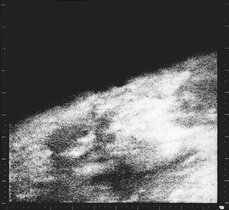 Exactly 50 years ago, on June 19, 1963, Mars-1, the first spacecraft in history launched on the flight path to Mars, became as close as possible to the planet at a distance of about 200 thousand km. It was “Mars-1” that was to be the first in the history of the device to photograph its surface ...
Exactly 50 years ago, on June 19, 1963, Mars-1, the first spacecraft in history launched on the flight path to Mars, became as close as possible to the planet at a distance of about 200 thousand km. It was “Mars-1” that was to be the first in the history of the device to photograph its surface ...But he did not: because of the leakage of nitrogen from the cylinders of the orientation system, a highly directional antenna could not be pointed to Earth and communication with the device ceased. And the first television image of Mars with a resolution of 200 lines of 200 pixels we received from the American "Mariner-4" in 1965.
(Beware, a lot of photos!)
')
Probably, this post was supposed to be the first among the descriptions of photo devices intended for shooting Mars. But it so happened that I wanted to write about HiRISE immediately after the success of the project among the Russian-speaking audience. The idea of telling about the unique HRSC stereo camera came from the widely known in narrow circles, habrauser-marsoved Zelenyikot . But the idea to make a comparison of all the cameras that have ever shot Mars, came already in the process. And, probably, it was not by chance that this coincided with the 50th anniversary of the passage (albeit uncontrollable) of the Soviet apparatus.
Here is the entire technical part of the article in two tables.
* image width, length determined by scan time
The main parameters of the shooting apparatus | |||
|---|---|---|---|
| Tool | Focal length | Spectral range | The number of transmitted images,% of the surface of Mars |
| Mariner 4 (United States, 1965) | |||
| Vidicon | 305 mm | Red Green | 22 (1%) |
| Mariner 6, 7 (United States, 1969) | |||
| Vidicon (Camera A) | 52 mm | Red, green, blue, yellow | Mariner 6 - 75 Mariner 7 - 126 Only about 20% |
| Vidicon (Camera B) | 508 mm | ||
| Mariner 9 (United States, 1971-1972) | |||
| Vidicon (Camera A) | 50 mm | without filters | 7329 (2% with a resolution of 100-300 m, 85% with a resolution of 2 km) |
| Vidicon (Camera B) | 500 mm | ||
| Mars-2, 3 (USSR, 1972) | |||
| Vidicon | 52 mm | Red, Green, Blue, UV | 60 |
| Vidicon | 350 mm | ||
| Mars-4, 5 (USSR, 1973) | |||
| Vega-3MSA | 52 mm | Red, green, blue, orange | 60 |
| Zufar-2SA | 350 mm | ||
| Viking 1, 2 (United States, 1976-1980) | |||
| 2 x Vidikon VIS A, B | 475 mm | 0.35 - 0.7 | 50488 (28% with R <100 m, 100% with R <400 m) |
| Mars Global Surveyor (USA, 1997-2006) | |||
| Mars Orbiter Camera MOCNA | 3500 mm | 0.5 - 0.9 | 85859 (3%) |
| Mars Orbiter Camera MOCWA | 11.5 mm | 0.575 - 0.625 0,400 - 0,450 | 93893 32414 Only 100% (R = 225) |
| Mars Odyssey (USA, since 2001) | |||
| Thermal emission imaging system (THEMIS VIS) | 200 mm | 0.425 - 0.860 | almost 115 thousand (100%) |
| Thermal emission imaging system (THEMIS IR) | 6.78 - 14.88 | ||
| Mars Express (Europe, since 2004) | |||
| High-resolution stereo camera (HRSC) | 175 mm | 0,395 - 1,015 | |
| Super-resolution channel (SRC) | 975 mm | 0.475 - 0.725 | |
| Mars reconnaissance satellite (Mars Reconnaissance Orbiter) (USA, since 2006) | |||
| High resolution imaging science experiment (HiRISE) | 12,000 mm | 0.4 - 1.0 | |
| Context camera (CTX) | 350 mm | 0.5 - 0.8 | |
| Mars color imager (MARCI) WA | 4.3 mm | 0.225 - 0.775 | |
Image Resolution | |||
|---|---|---|---|
| Tool | Image resolution | Surface resolution (meters per pixel, no more) | Radiometric resolution |
| Mariner 4 (United States, 1965) | |||
| Vidicon | 200 lines of 200 px | 860-1500 | 6 bits |
| Mariner 6, 7 (United States, 1969) | |||
| Vidicon (Camera A) | 704 lines with 935 px | 3000 | 6 bits |
| Vidicon (Camera B) | 300 | ||
| Mariner 9 (United States, 1971-1972) | |||
| Vidicon (Camera A) | 700 lines of 832 px | 500 | 9 bits |
| Vidicon (Camera B) | 50 | ||
| Mars-2, 3 (USSR, 1972) | |||
| Vidicon | 1000 lines of 1000 px | 10-100 | |
| Vidicon | |||
| Mars-4, 5 (USSR, 1973) | |||
| Vega-3MSA | 1760 lines of 1880 px | 100-1000 | |
| Zufar-2SA | |||
| Viking 1, 2 (United States, 1976-1980) | |||
| 2 x Vidikon VIS A, B | 1056 lines of 1182 px | 7-1400 | 7 bit |
| Mars Global Surveyor (USA, 1997-2006) | |||
| Mars Orbiter Camera MOCNA | 2048 px (line-scan) * | 1.4-12 | 8 bit |
| Mars Orbiter Camera MOCWA | 3456 px (line-scan) | 225-7500 | |
| Mars Odyssey (USA, since 2001) | |||
| Thermal emission imaging system (THEMIS VIS) | 1024 px (line-scan) | 18 | 8 bit |
| Thermal emission imaging system (THEMIS IR) | 320 px (line-scan) | 100 | |
| Mars Express (Europe, since 2004) | |||
| High-resolution stereo camera (HRSC) | 5184 px (line-scan) | ten | 8 bit |
| Super-resolution channel (SRC) | 1024x1024 | 2.3 | 14 bits |
| Mars reconnaissance satellite (Mars Reconnaissance Orbiter) (USA, since 2006) | |||
| High resolution imaging science experiment (HiRISE) | red - 20264 px (line-scan) green, blue, near infrared - 4048 px (line-scan) | 0.3 | 12-13 bits |
| Context camera (CTX) | 5064 px (line-scan) | 6 | |
| Mars color imager (MARCI) WA | 1024x1024 | 1000 | 12 bits |
"Mariner-4" (USA, 1965), a study from the flight path
The NASA spacecraft Mariner 4 flew around Mars on July 14-15, 1965 and was equipped with a long-focus camera (Vidicon) with f = 305 mm.
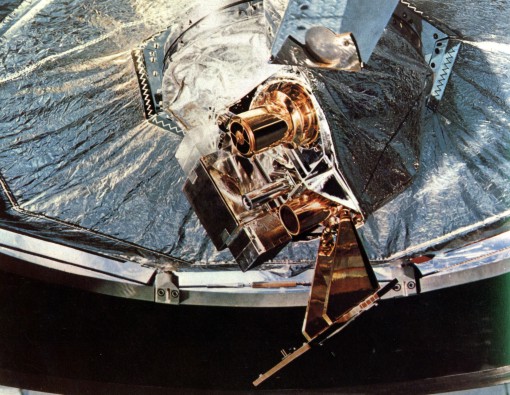
The camera was turned on at 00:18:36 UTC on July 15, taking a narrow arc on the surface of Mars: from 40 ° c. w., 170 ° c. d., then through the equator, near 35 ° S. w., 200 ° c. with the terminator crossing at 50 ° S. W, 255 ° c. d. (which in general is about 1% of the entire surface of the planet). The pictures were taken through red or green filters, and their pairs overlapped to get more information about the color of the surface. Image resolution was 200 lines of 200 pixels, 6 bits per pixel. A total of 21 full shots and partially 22 shots (21 lines) were received. The pictures were taken at different distances, with a minimum of 11.8 thousand km. The transfer of images was carried out at a speed of 8.33 bps (one frame took more than 8.5 hours) from a distance of more than 216 million km.
First frame:

The second frame:

Mosaic from the first and second frames:
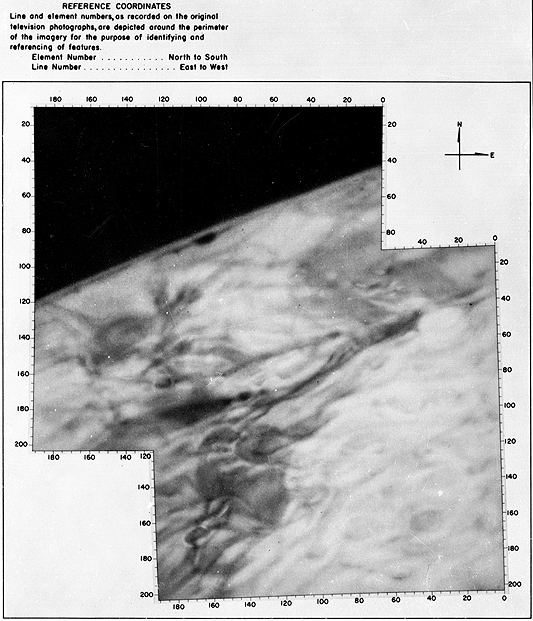
Catalog of all images of Mars from “Mariner-4”
Despite the fact that "Mars-1" could not become the first "photographer" of Mars, he had a much more powerful television equipment than the "Mariner-4". On board was a 32-kilogram photo-television camera, which could shoot with a resolution of up to 1,440 lines (720 lines in alternative mode or 68 lines in preview mode):
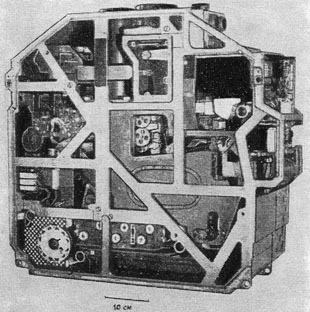
The camera contained both 35 mm and 750 mm optics; it used 70 mm film, which should have been enough for 112 frames. The shooting mode involved either square images or rectangular 3: 1. The captured and developed images were then to be scanned and transmitted to Earth. The camera also had an ultraviolet spectrograph: the UV spectrum was recorded immediately behind the captured image. In addition, the camera had a 3-4 micron infrared diffraction spectrometer located parallel to its optical axis. Given the secrecy of the Soviet space exploration projects, we can only assume that the constructor of this camera was P.F. Bratslavets (his "Yenisei" first removed the reverse side of the moon in 1959).
The Mars-1 camera was equipped with its own 6 GHz transmitter, which, consuming 50 W, produced short pulses of 25 kW each. At that time, redundant systems had not yet been applied, and high-power pulsed transmission was a truly ingenious invention for increasing capacity at a distance of 300 million kilometers. Images should be transmitted pixel-by-pixel at a speed of approximately 90 pixels per second, which would require more than 6 hours to transfer a single image with a resolution of 1440x1440.
"Mariner-6" and "Mariner-7" (USA, 1969), study from the flight path
Two identical NASA spacecraft Mariner-6 and Mariner-7 were launched on February 24 and March 27, 1969, respectively, and passed around Mars at a distance of 3.4 thousand km on July 31 and August 5. On each unit, two television cameras (Vidicon) were installed: wide-angle (f = 52 mm) for shooting a full disc of Mars from long distances and a long-focus (f = 508 mm) for shooting while approaching the planet. At the closest approach, the image of the long-focus camera covered the area of the planet’s surface approximately 72x84 km and made it possible to distinguish craters up to 300 m in size. The wide-angle camera produced an image 100 times larger than the long-focus one.
When shooting at close range, the cameras worked alternately at intervals of 42 s between exposures. The wide-angle camera was equipped with red, green and blue filters, mounted in the holes of the rotating flap. The long-focus camera had only a yellow filter to eliminate the “blue haze” that could be present in the atmosphere of Mars.
The optical system of each camera created a television image consisting of 704 lines of 935 pixels each. Each pixel has 8-bit encoding. Of course, the technical capabilities of that period did not allow to transfer the image in real time and were recorded on a magnetic tape, and two recording systems were used: digital (in binary format with a capacity of 13 Mbps) and analog with an effective capacity of 120 Mbps. In total, Mariner-6 transmitted 75 images (including 26 from a long-focus camera), Mariner-7 - 126 images (including 33 from a long-focus camera). The total surface area, which is represented in the pictures from a short distance, was about 20%.
Examples of images from "Mariner 6" and "Mariner 7":
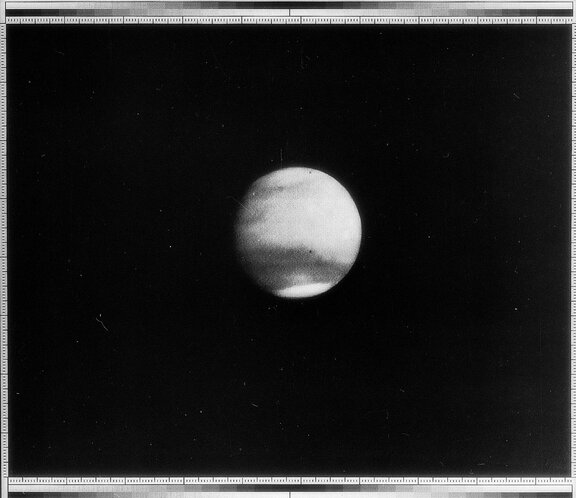
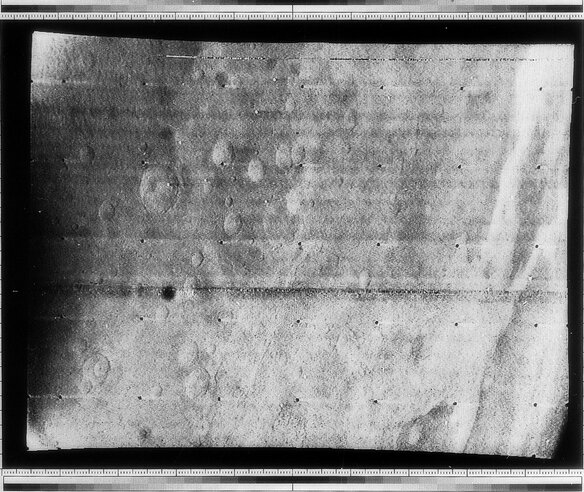
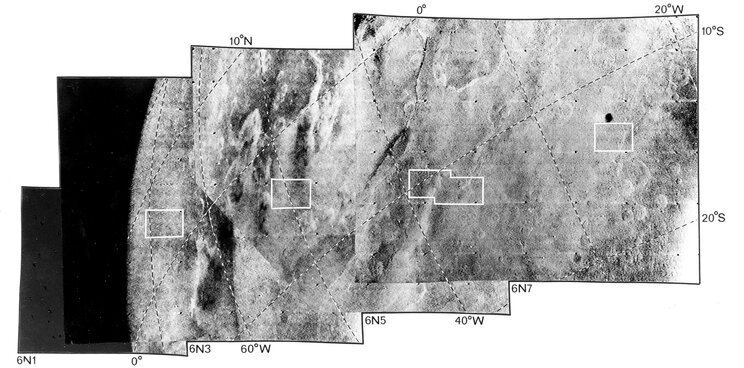
More photos can be viewed here and here .
In the same year of 1969, with a difference of a week, the USSR launched spacecraft of the M-69 series: “Mars-1969A” and “Mars-1969B”, which included 3 television cameras (35, 50 and 250 mm) that could color TV shows, as well as take pictures of 1024x1024 pixels and a maximum spatial resolution of up to 200 meters. The number of images stored on one camera could be 160.
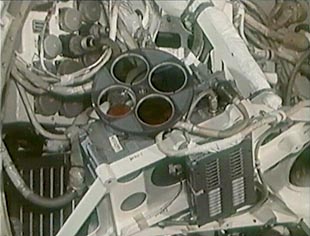
However, both ships as a result of missile launch accidents failed to go beyond the Earth: Mars 1969A exploded and fell in the Altai Mountains as a result of the main engine failure at 439 seconds, Mars 1969B as a result of failure first, and then 5 remaining boosters, exploded already at 41 seconds after launch, reaching a height of 3 kilometers.
Mariner-9 (USA, 1971-1972)
Mariner-9, as well as most of the devices of its time, was equipped with two cameras: wide-angle and long-focus (f = 500 mm). Cameras had approximately the same characteristics as in “Mariners-6, 7”: 700 lines with 832 pixels each. The image was recorded on film in the form of a rectangle with a physical size of 9.6 x 12.5 mm. The field of view angles for the long-focus camera were 1.1x1.4 ". Mariner-9 was originally planned to be taken on the surface of Mars immediately after it entered the planet’s orbit, but due to a dust storm that began on September 22, 1971, the entire scientific program was in doubt (it was impossible to predict when the atmosphere would calm down and the details of the surface would be available for observation).
For 349 days of work on the near-Martian orbit, the spacecraft transmitted a total of 7329 images, covering about 85% of the planet’s surface with a resolution of 1 to 2 km (2% of the surface were photographed with a resolution of 100 to 300 meters). The pictures show dried river beds, craters, huge volcanic formations (such as Olympus Volcano - the largest volcano found in the Solar System), canyons (including the Mariner valleys - a giant system of canyons over 4000 kilometers long), signs of wind and water erosion and displacement layers, weather fronts, fog and many more interesting details. Also, the satellites of Mars, Phobos and Deimos were photographed (at the end of 1971 about 40 images were taken, then about 70 more). Mariner-9 will remain in Mars orbit for about 50 years, after which it will enter its atmosphere.
Sample images:

Labyrinths in the western part of the Mariner Valleys
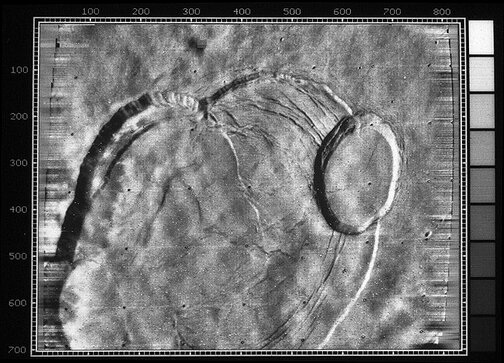
Central Caldera of Mount Olympus
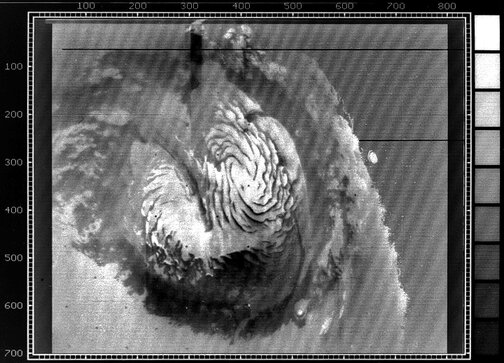
Cap on the North Pole
More photos from Mariner 9 can be viewed here and here .
"Mars-2" and "Mars-3" (USSR, 1972)
These spacecraft were created in the USSR as part of the M-71 project, which provided for the launch of three spacecraft in 1971. As in the case of Mariners-6, 7, constructively Mars-2 and Mars-3 were similar and duplicated each other in case of a possible failure. The devices were equipped with photo and television installations with f = 52 mm and f = 350 mm. Because of the problems with telemetry at Mars-2, only a few images of the planet were obtained from this device, which, moreover, almost all the relief was hidden by a sandstorm raging at that moment:
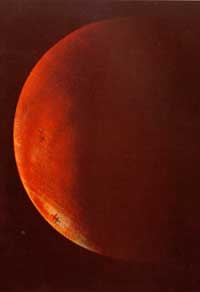
Mars-3 continued to shoot, but due to the failure of one of the transmitters, the images were transmitted only in low quality (250 lines), although the equipment maintained a resolution of up to 1000 lines of 1000 px. As it turned out, in addition to the sandstorm and problems with the transmitter, the developers of television installations used the wrong model of Mars, so the wrong shutter speeds were chosen. The pictures were obtained by lightened, almost completely unsuitable (in the pictures: the boundary of the atmosphere of Mars and the mountains near the equator):

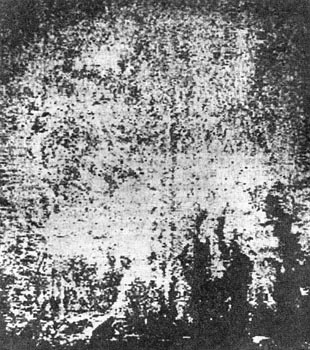
The history of the Mars-3 descent module has already been highlighted in Habré. Therefore, for completeness, I will only leave the most unreadable image of 79 lines that the module managed to transmit to Earth:
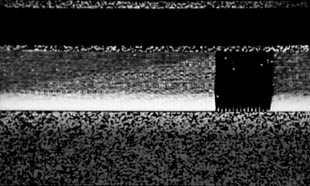
"Mars-4" and "Mars-5" (USSR, 1973)
"Mars-4" and "Mars-5" used several advanced photo and television installations from "Mars-3" (improved optics, new photomultiplier tube FEU-103):
Zufar-2SA long-focus camera (f = 350 and viewing angle of 5.67 °):
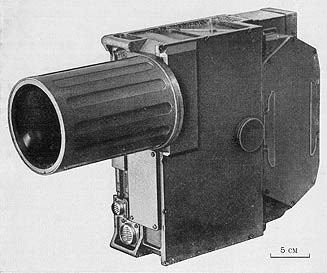
Wide-angle camera "Vega-3MSA" (f = 52 and viewing angle of 35.7 °):
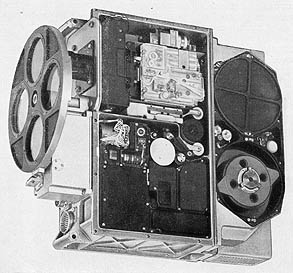
Each camera had 20 meters of 25.4 mm film, which should have been enough for 480 frames. The exposure time ranged from 1/50 to 1/150 s, after which the film appeared and was scanned. There were 10 different scanning modes, but in practice 3 main ones were used: all images in previews are 235x220 in size, some in the normal resolution of 940x880, and particularly interesting details - with a maximum resolution of 1880x1760 pixels. The pulse transmitter could operate in modes from 512 to 1024 pixels per second.
"Mars-4" in accordance with the scientific program was to go into orbit around the planet and provide communication with the automatic Martian stations intended for work on the surface. Two minutes before the pericenter of the approaching hyperbola, the wide-angle “Vega” was turned on (due to a malfunction of the long-focus camera detected 5 days before approaching, this photo-television device did not turn on). A 12-frame cycle of the survey of Mars from a flying trajectory at a distance of 1900/2100 km on a scale of 1: 5000000 was carried out The pictures were of good quality:
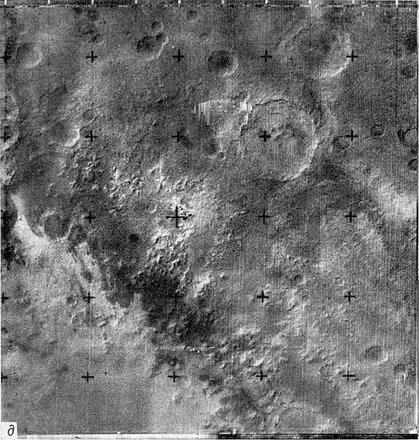
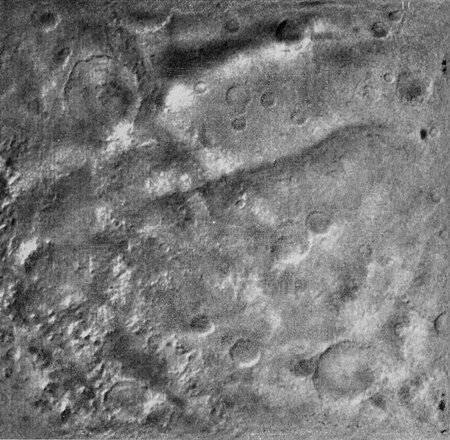
In addition, using photophotometers, we surveyed panoramas of two regions of the surface of Mars (in the orange and red-infrared ranges):


Due to a malfunction in the operation of one of the onboard systems, the Mars-4 brake propulsion system did not turn on and the AMC passed near the planet along a flight path, approaching a minimum distance of 1,844 km, continuing flight in a heliocentric orbit.
Mars-5, unlike its predecessor, successfully entered the orbit of the Red Planet and transmitted 60 images taken through blue, red, green, and additional special orange light filters with surface resolutions from 100 m to 1 km.
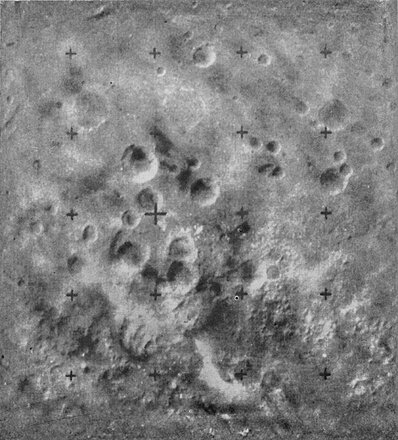

Composite images (RGB):

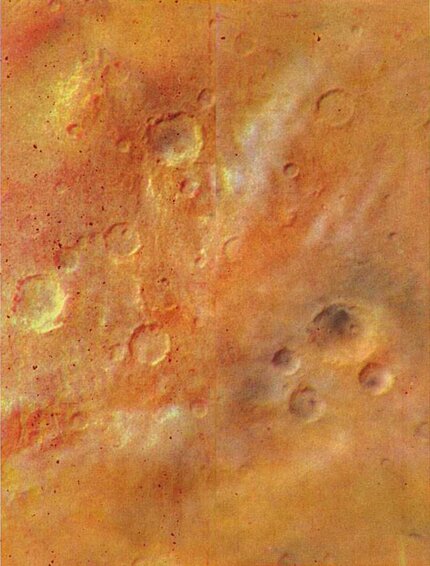
More photos of Mars from the Soviet missions here .
Viking-1 and Viking-2 (United States, 1976-1980)
Successes "Vikings", as a rule, are described by the first successful experience of the descent vehicle. However, each orbital station possessed two television cameras (f = 475), which in 5 years of the mission took more than 52 thousand images. The optical system of the apparatus was a Schmidt-Cassegrain system with MTF = 0.7 at a Nyquist of 42 lp / mm:

The resolution of the cameras was 1056 lines of 1182 pixels. Between the lenses and the mechanical shutter there was a wheel with six color filters: blue (0.35 - 0.53 μm), negative blue (0.48 - 0.70), purple (0.35 - 0.47), green ( 0.50 - 0.60), red (0.55 - 0.70) and clear. The viewing angles of the cameras were 1.54 ° x 1.69 °, which was about 40x44 km on the surface at an altitude of 1500 km. When shooting, the overlay mode was provided, which allowed later to combine images into large-scale mosaics with almost no loss of quality:
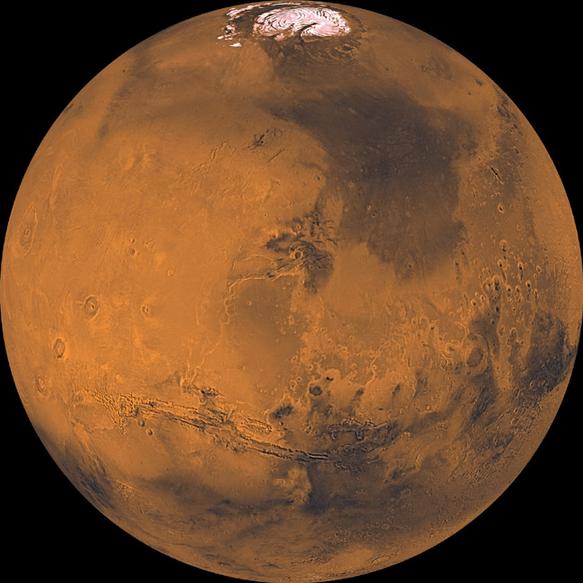
The exposure time of each image ranged from 0.003 to 2.66 seconds. Cameras could shoot one image at 8.96 s, with the interleaving of cameras, the orbiter could receive an image every 4.48 s. Images were digitized with 7 bits and recorded on a magnetic tape.

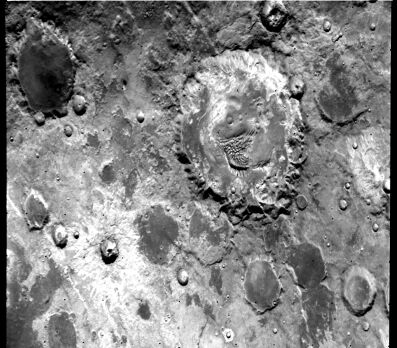

Catalog of images from the "Vikings" here and here .
Mars Global Surveyor (USA, 1997-2006)
This orbital device for the first time had on its board a camera based on a CCD - Mars Orbiter Camera (MOC):

The scanning camera had both wide-angle (140 °) and narrow-angle (0.4 °) optics, which ensured both global surface shooting (7.5 km per pixel) and high resolution for certain areas (up to 1.4 meters at pixel).
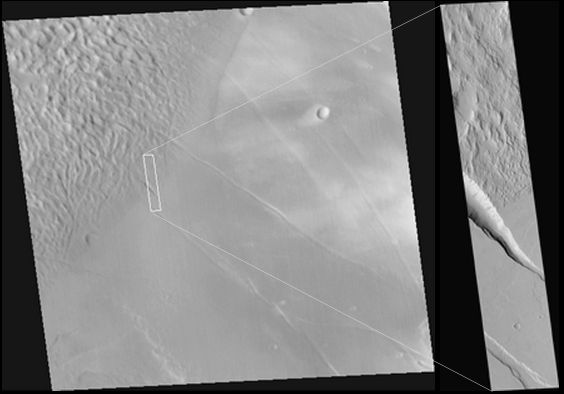
The optical system of the narrow-angle camera was represented by a Richie-Chretien telescope with a focal length of 3.5 m and a set of filters for operation in the range of 500–900 nm. The wide-angle camera had a focal length of 11.4 mm:
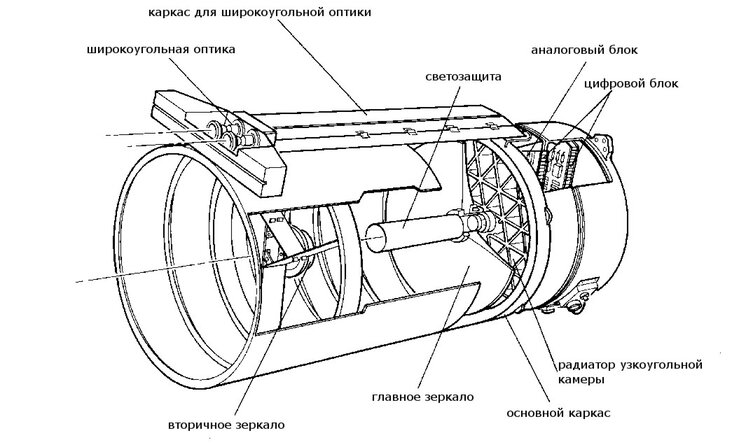
The CCD matrix of the wide-angle camera consisted of 3456 elements, the narrow-angle one - of 2,048 elements, the control electronics unit included a 32-bit (10 MHz, 1 MIPS) SA3300 microprocessor, 4 ASIC, 128 kB EPROM, 192 kB SRAM, 12 MB DRAM.
Sample images:
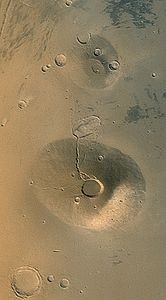

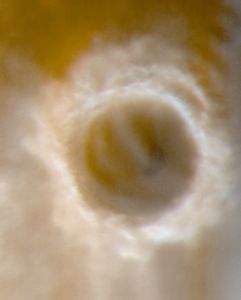
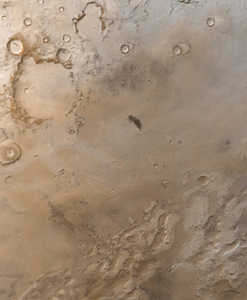
Image catalogs: here and here (mapped) ,
Mars Odyssey (USA, since 2001)
The Mars Odyssey has a THEMIS (Thermal Emission Imaging System) device onboard designed for multispectral imaging of the surface of Mars in the visible and infrared parts of the spectrum. THEMIS was created on the basis of the MARCI camera from the Martian climate satellite and has a surface resolution of 100 and 20 m in the infrared and visible range, respectively:
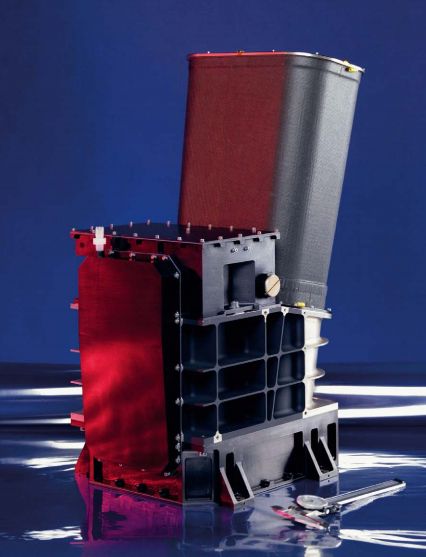
With the help of this camera, a complete accurate map of Mars was obtained with a spatial resolution of 100 m. To compile it, scientists used 21,000 photographs taken by an artificial satellite for eight years.
Features of the camera due to the main task of the mission - the study of the geological structure of the planet and the search for minerals. In the visible range, the camera operates with the following frequencies: 0.425 μm, 0.540 μm, 0.654 μm, 0.749 μm, 0.860 μm, in the infrared - 6.78 μm, 7.93 μm, 8.56 μm, 9.35 μm, 10.21 micron, 11.04 micron, 11.79 micron, 12.57 micron, 14.88 micron.
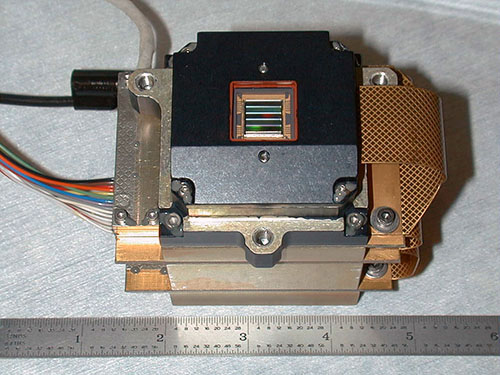
Color filters of the camera operating in the visible part of the spectrum
How the camera works in the infrared: during the day the sun heats the surface of Mars and some minerals begin to radiate the heat. THEMIS records the characteristics and location of these emissions, forming the final image. The array of microbolometers 320x240 elements in size serves as detectors. For the visible radiation in the receiver, a matrix of silicon detectors 1024x1024 was used. The instrument optics are represented by a telescope with an aperture of 120 mm (f / 1.6). The angles of view for an infrared camera are 4.6 ° x 3.5 °, for a camera in the visible range - 2.66 ° x 2.64 °.
Sample images:


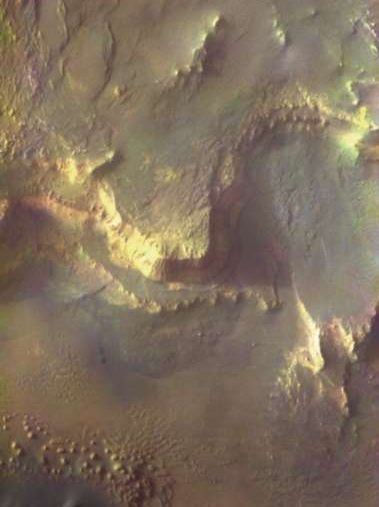
Catalog of images with cartographic binding
Mars Express (Europe, since 2004)
Mars Express is the first space station in Mars orbit that had a stereoscopic high-resolution camera (High Resolution Stereo Camera (HRSC)) on board:
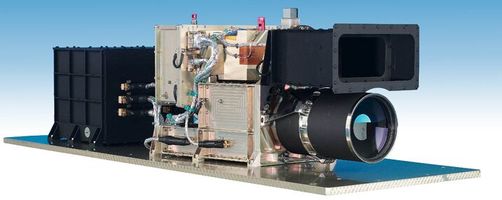
HRSC is a nine-channel CCD-based camera, which allows you to take pictures with details up to 2 meters, as well as build digital elevation models. Optics HRSC, located in the camera head, is an Apo-Tessar lens with a focal length of 175 mm (f / 5.6). The CCD array consists of 9 Thomson THX 7808B elements, each of which contains 5184 pixels with a physical size of 7 μm, which provides a surface resolution of 10 m per pixel at a flight altitude of 250 km. The spectral ranges of the camera: 675 ± 90 nm, blue - 440 ± 45 nm, green - 530 ± 45 nm, red - 750 ± 20 nm, near-infrared -970 ± 45 nm. Read in detail about the camera here .
Mars Express also had separate optics and a dedicated channel for super-resolution shooting: the Super Resolution Channel (SRC).The SRC optical system is a Maksutov-Cassegrain telescope with a focal length of 972 mm (f / 11), the axes of which are located parallel to the optical axis of the HRSC. SRC sensors - a Kodak KAI 1001 CCD with a continuous scan of 1024x1032 px and a pixel size of 9 microns, which gives 2.3 m of surface per pixel at an altitude of 250 km.
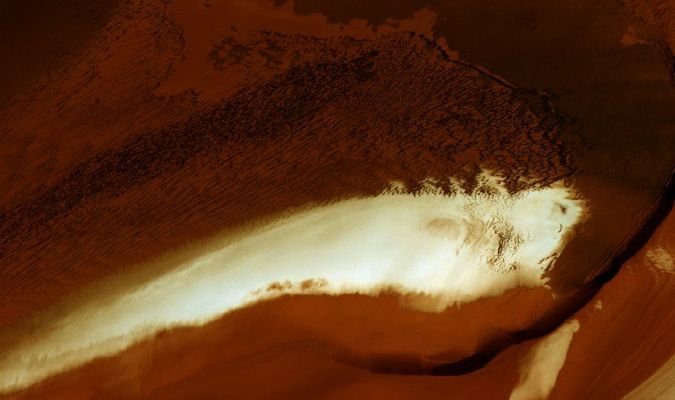


HRSC Image Catalog
Mars Reconnaissance Orbiter (USA, since 2006)
MRO is the most modern and multifunctional automatic interplanetary station designed for the exploration of Mars. On its board as part of scientific equipment has three cameras: High Resolution Imaging Science Experiment (HiRISE), Context Camera (CTX) and Mars Color Imager (MARCI).
HiRISE is a camera using a reflecting telescope with a diameter of 0.5 m, which gives a spatial resolution of 0.3 meters per pixel. Today it is the largest telescope used in deep space. The photodetector of the device is an astigmatic reflector telescope Cassegrain with a system of 3 mirrors. The CCDs are zigzagged to close the entire passage area, without any gaps. The blue-green and near-infrared ranges each have 2 detectors with a total bandwidth of 4048 px, for the red band there are 10 detectors with a total width of 20264 px. Each CCD contains 2048 pixels with a physical size of 12 μm. A detailed review of HiRISE can be found in the corresponding article .
Examples of images (in the extended color range):
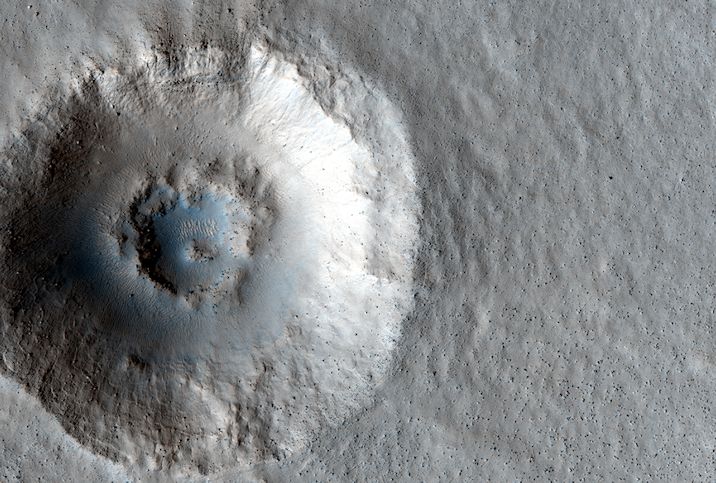
Crater with a double ring
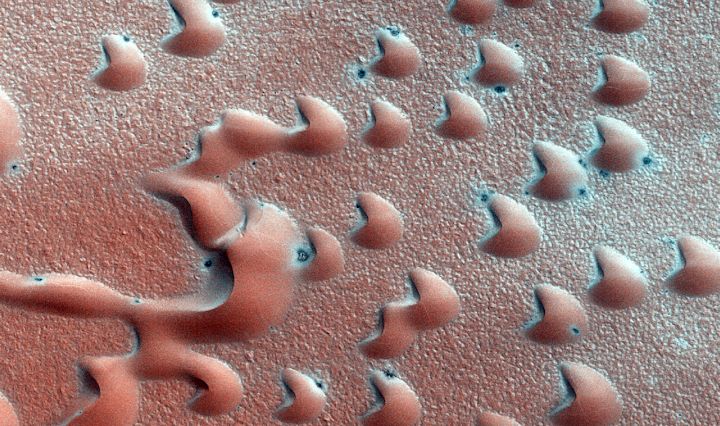
Sand Dunes
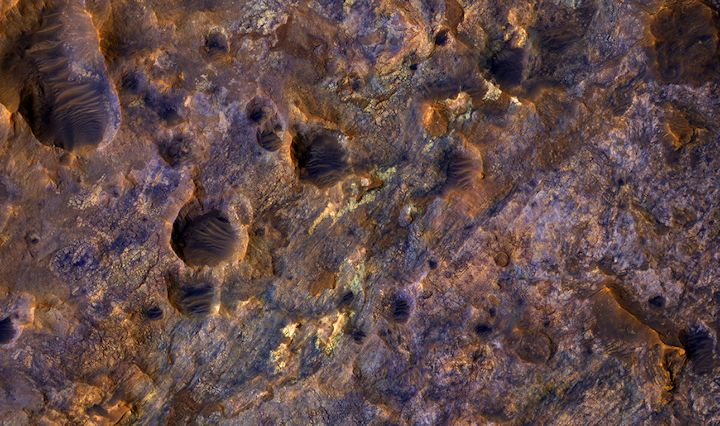
Clay deposits in the northern part of the plain Mavrt
HiRISE image catalog: mapped or on the project website itself . In addition, there is a Russian-speaking Tumblr , regularly updated with fresh photos.
CTX is a panchromatic context camera that captures monochrome images in the range of 0.5 - 0.8 μm with a maximum resolution of images up to 6 meters per pixel.
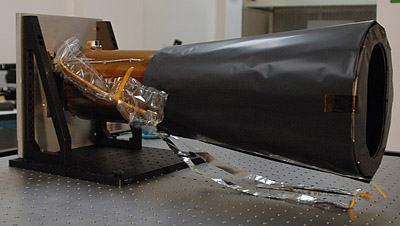
CTX was intended to create a contextual map of Mars, which in the future would be useful for observing the HiRISE camera and the CRISM spectrometer, along with this camera is used in creating mosaics of large surface areas of Mars, in long-term observations of changes in the surface of individual areas, and for creating stereo images of key regions and potential landing sites for future missions. Optics CTX consists of a mirror-lens telescope of the Maksutov-Cassegrain system with a focal length of 350 mm and a CCD array of 5064 pixels. The device is capable of capturing a plot of 30 km wide, and has enough internal memory to save an image with a total length of 160 km.
Sample images:
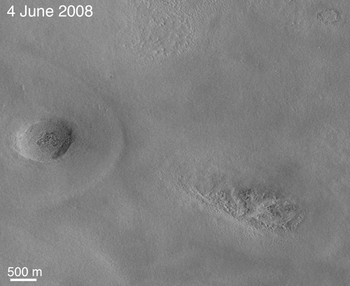

The emergence of a new shock crater

This may well be an original greeting for your girlfriend :)
(for non-romantics: this is just one of the many formations in the chaos of Hydasp)
The CTX
MARCI image catalog is a wide-angle camera that takes down the surface of Mars in the five visible and two ultraviolet ranges.
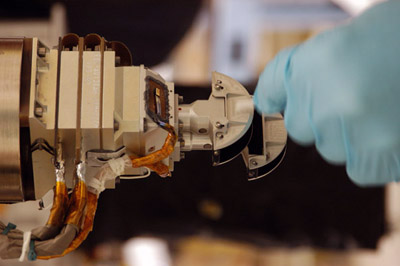
The resolution of its images is relatively small: from 1 to 10 km per pixel. Maps created with this camera represent the daily weather forecast for Mars . They can be used to analyze seasonal and annual temperature fluctuations, as well as to detect the presence of water vapor and ozone in the atmosphere of Mars. MARCI has a 180-degree fisheye lens with a set of seven color filters directly connected to a single CCD sensor.
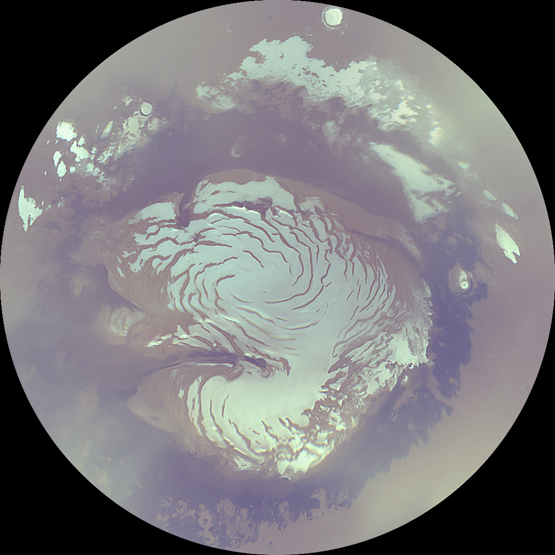
The cap of the North Pole of Mars
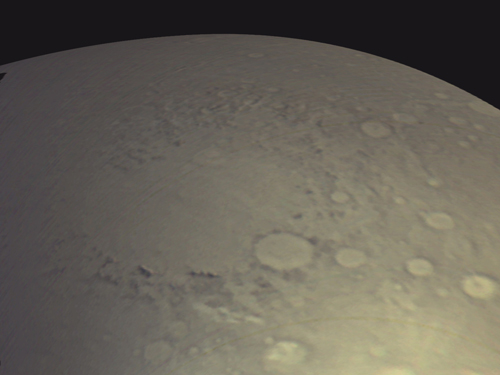
Oblique perspective (mixing the three ranges: 425 nm, 500 nm, 600 nm)
So, this small review of photographic equipment, which has been giving us inspiration for the Red Planet for almost 50 years, has come to an end. Looking at the ingenious engineering solutions of the middle of the last century, peering into the stunningly beautiful modern megapixel panoramas, it is difficult to believe that this is the work of human hands. And while we divide our scientific achievements into “our own” and “aliens”, even if we are waiting for fresh news from Mars from NASA and not from Roscosmos, we still want to believe that in the near future, national boundaries in the development of space will be erased.
Source: https://habr.com/ru/post/183594/
All Articles